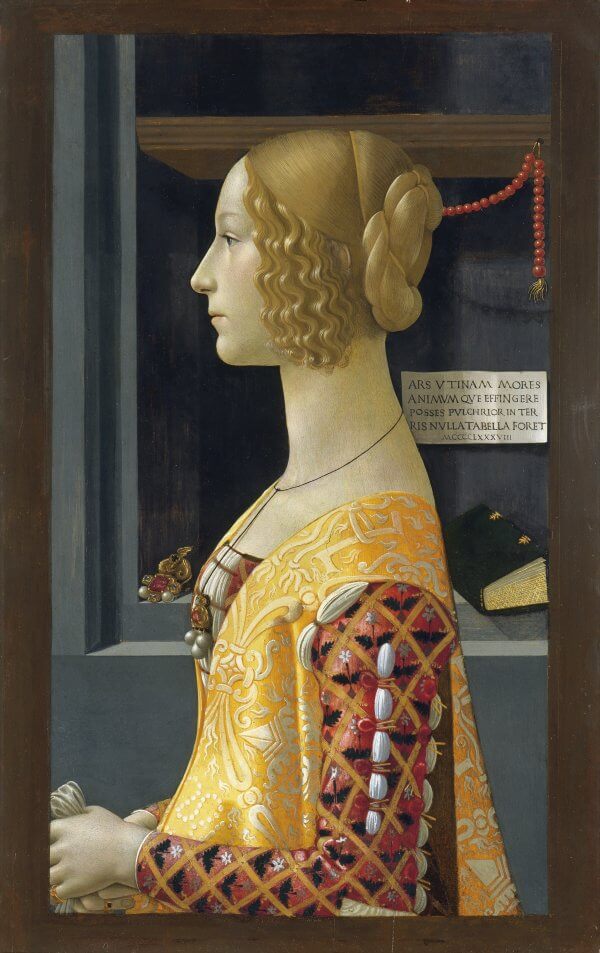What to see in Thyssen Museum: 13 Highlights and Famous Paintings
Written by Nadia Podrabinek
Hello, my name is Nadia. I usually write about traveling (there are so many places to fit all the lifestyles), relocation, and living in a foreign country (adapting to a different culture). My travels stretch beyond Spain, with journeys to the US, Italy, Norway, Portugal, and France. Relocating to Spain in 2018, I lived in cities from Barcelona to Madrid, currently calling Valencia home. Follow me on Twitter, Facebook, Instagram, or LinkedIn! ... show more
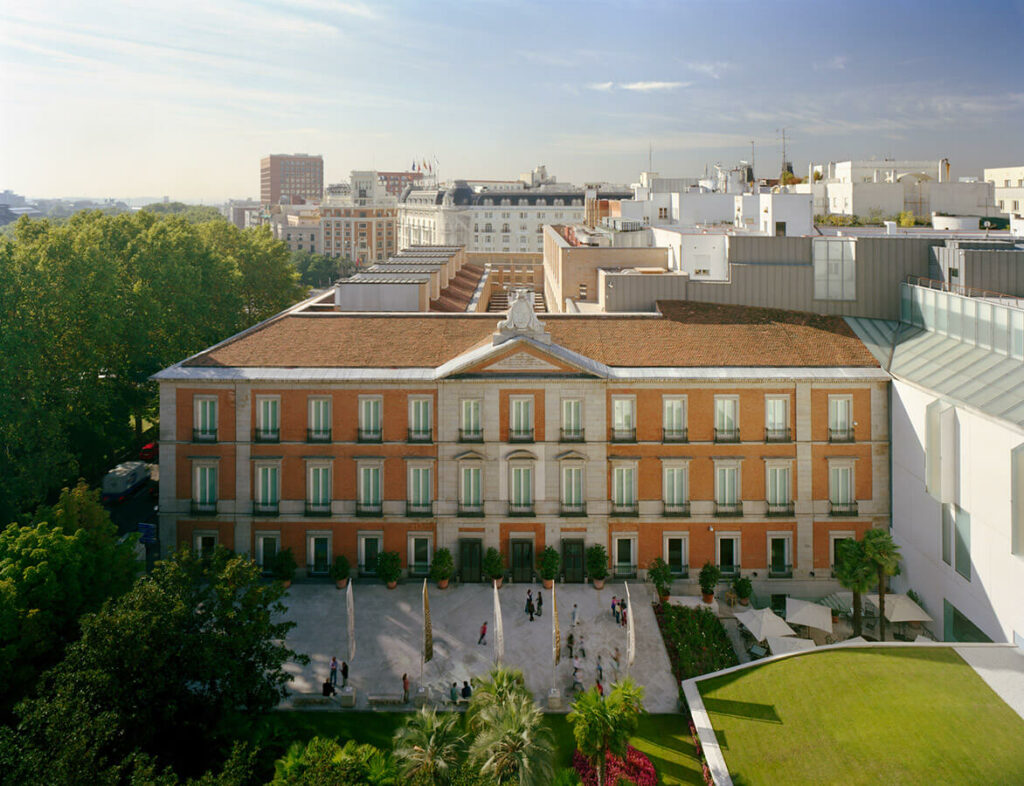
Thyssen Museum is a relatively new art museum in Madrid, Spain. It has a fantastic artworks collection and is considered a part of Madrid’s Golden Triangle of Art (with Prado Museum and Reina Sofia Museum). About 1 million people visit Thyssen Museum each year.
In fact, the museum is called Thyssen-Bornemisza National Museum (not Thyssen Museum) and is pronounced as [ˈtisem boɾneˈmisa].
How the Thyssen collection was created
The Thyssen-Bornemisza collection was created from one of the greatest private collections of the 20th century.
Heinrich Thyssen, a noble baron from Germany, was an avid art collector. He used his family’s wealth to buy old master paintings from improvised American businessman.
During the Great Depression, his son Hans would continue building the family collection, although his tastes were a bit more modern. It was his fifth wife, Carmen Cervera, who convinced him to move the family collection to Spain, her home country.
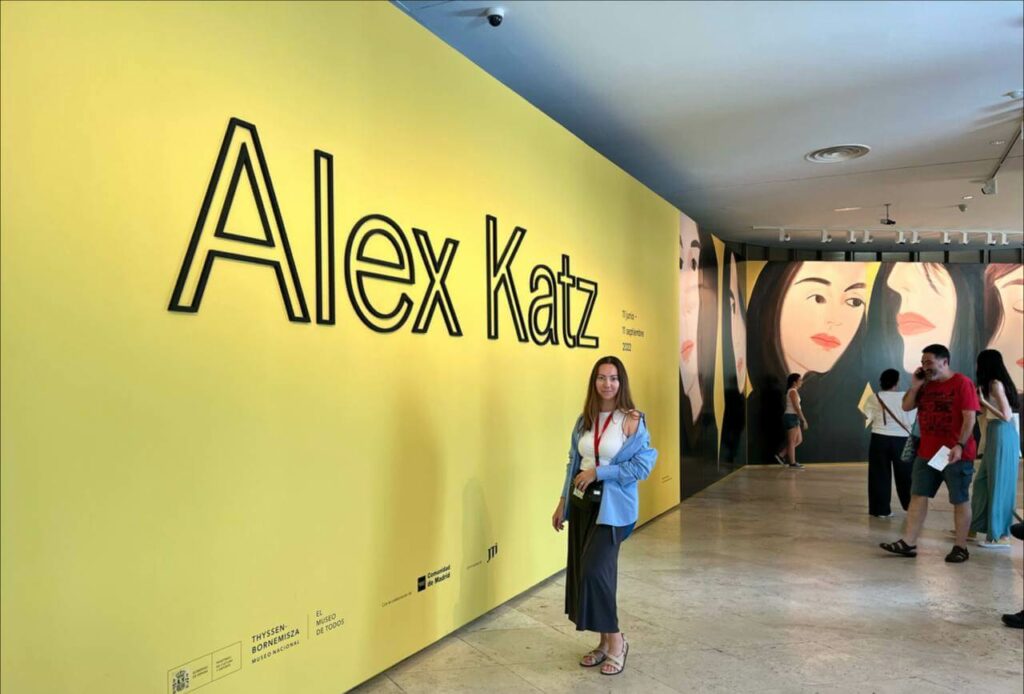
In 1992, the private collection was officially open to the public as the Thyssen-Bornemisza museum. But it wasn’t until 1993 that it was sold to the Spanish state. The government bought 775 works for an astounding 350 million dollars.
In addition, Carmen Saver loaned her collection to the state. Although the agreement expired in 2011, she continues to renew it every year so that people can enjoy it.
Today, the Thyssen-Bornemisza collection has around 1500 works that span 800 years of art in its collections.
Best Thyssen-Bornemisza Paintings and Highlights
1. The Annunciation Dyptich, Jan van Eyck, 1433-1435
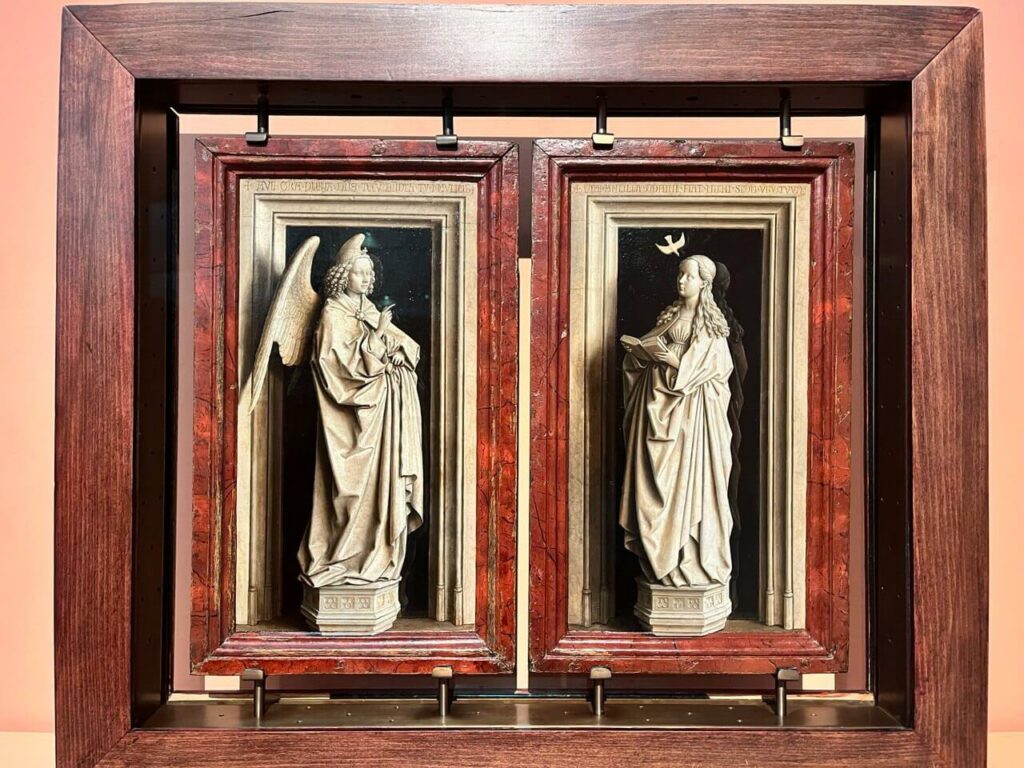
Jan van Eyck was an early Netherlandish pioneering painter of the Northern Renaissance, diplomat, portrait master, and author of more than a hundred religious paintings.
“The Annunciation” was created during the heyday of his work. The painter was preparing a gift for the Duke of Burgundy, Charles the Bold. The gift was a large religious triptych showing the Annunciation of Virgin Mary. Unfortunately, only one fragment of a fairly large-scale work has survived, the left wing.
In technical terms, the detailed drawing is striking and figures are extremely realistic.
2. Portrait of Giovanna degli Albizzi Tornabuoni, Domenico Ghirlandaio, 1489-1490
Domenico Ghirlandaio was one of the leading Florentine artists of the Quattrocento period, the founder of an artistic dynasty.
This painting is a posthumous portrait of Lorenzo Tornabuoni’s wife Giovanna, who died in childbirth. The picture was painted two years after her death in 1488 and included many symbolic details.
This picture shows one of the classic examples of Renaissance portraiture, which was painted in strict accordance with the rules of the genre. The portrait is half-length, the human figure is shown in profile, the hands are brought together, and the appearance and proportions of the body are clearly idealized.
The matron’s face is calm, and emotions are entirely absent. An expensive decoration is clearly visible on the chest—a brooch with precious stones, worn on a silk thread. Giovanna is combed in medieval fashion, dressed in a luxurious outfit.
The important detail of the background in this portrait is the inscription behind Giovanna. It is a modified excerpt of a poem. The epigram says (in Latin): “Art, would that you could represent character and mind! There would be no more beautiful painting on Earth”.
3. Young Knight in a Landscape, Vittore Carpaccio, around 1505
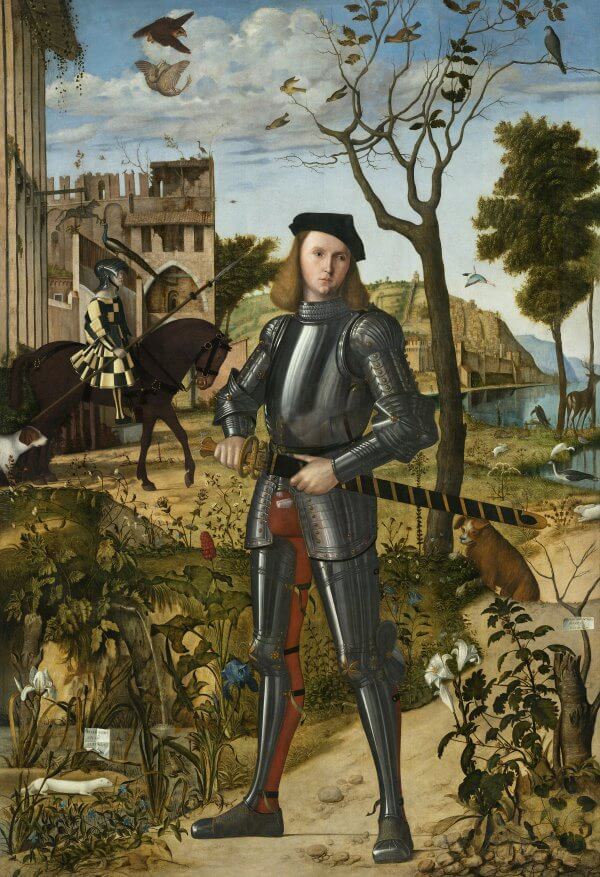
Vittore Carpaccio was an Italian painter of the Early Renaissance, representing the Venetian school. His famous painting “Young Knight in a Landscape” was the earliest full-length portrait in Western painting. Until 1919, the canvas was attributed to Albrecht Dürer, because the painting was monogrammed and Carpaccio’s signature was repainted.
The inscription “Motto malo mori quam foedari” (Better to die than be desecrated) placed next to the short-tailed weasel suggests that the depicted young man may be a knight of the Order of the Ermine, a chivalric order of the 14th and 15th centuries in the Duchy of Brittany.
In 2020-2021, the painting was restored. Details of the restoration and photos of works “before” and “after” can be seen in Thyssen Museum in Room 11 (2nd floor).
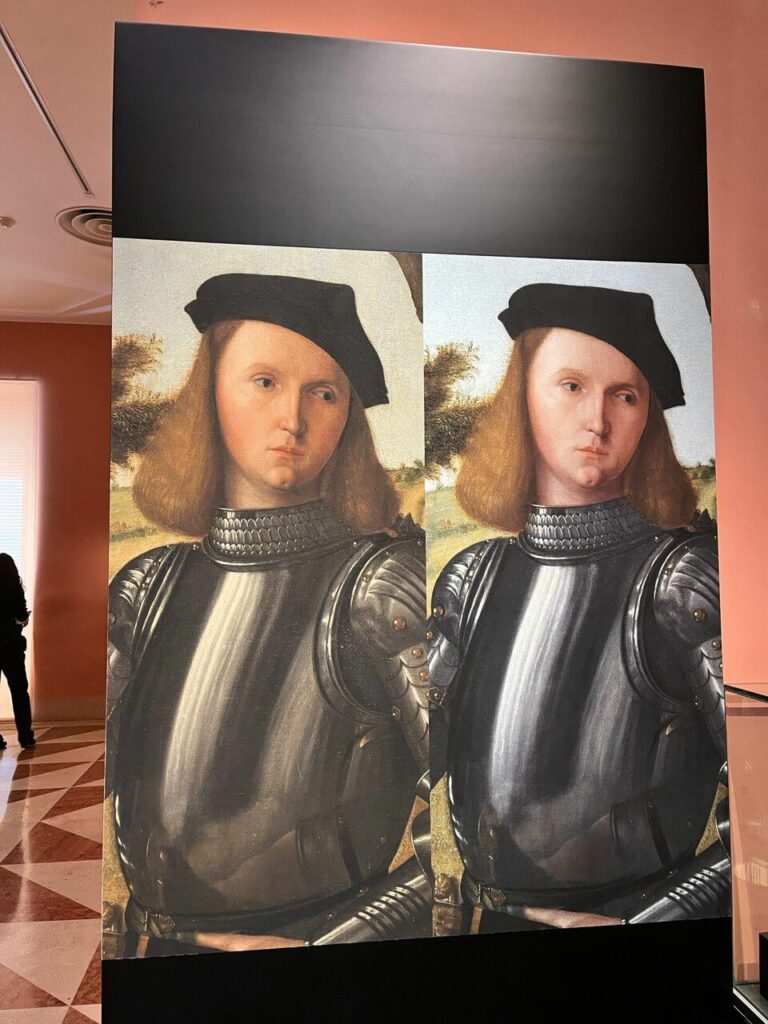
4. Jesus Among the Doctors, Albrecht Dürer, 1506
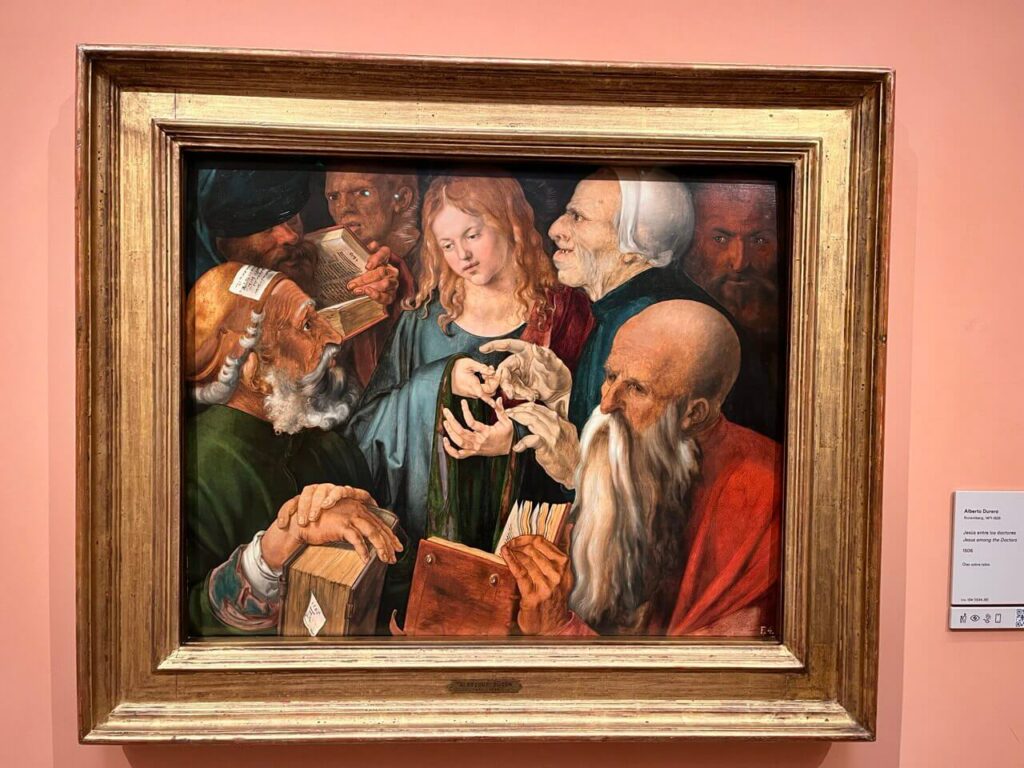
Albrecht Dürer was a prominent representative of German Renaissance art. He painted “Jesus among the doctors” during his second visit to Italy, where he was greeted as an unsurpassed artist.
The plot of the picture is taken from the canonical Gospels. Dürer highlighted the moment, the only one known between Christmas and the beginning of the ministry of Christ, associated with his fellowship with the scribes-priests in the temple of Jerusalem. The conversation of 12-year-old Jesus with the wise men is presented by the artist in a peculiar context.
Close-ups depict the faces and hands of the characters, which reveal the essence of what is happening. In contrast with the calmness and confidence of Jesus, we see the nervousness and embarrassment of the wise man’s hands next to the hands of Jesus.
The painting is signed with Dürer’s anagram on a piece of paper protruding from the book in the foreground.
5. Landscape with the Rest on the Flight into Egypt, Joachim Patinir, 1518-1524
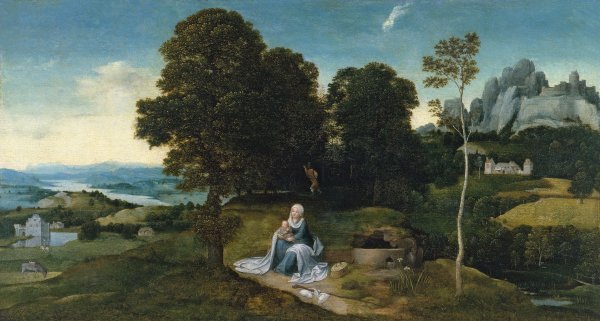
Joachim Patinir was a Flemish painter, one of the founders of European landscape painting as an independent genre. His paintings depicted religious subjects with Nature in the leading role.
He used a consistent and effective color scheme in his landscapes, influencing landscape painting later. The foreground is dominated by brownish hues, the midground is bluish green, and the background is pale blue, creating a dramatic sense of receding into the distance.
6. The Penitent Saint Jerome, Titian (Tiziano Vecellio), 1575
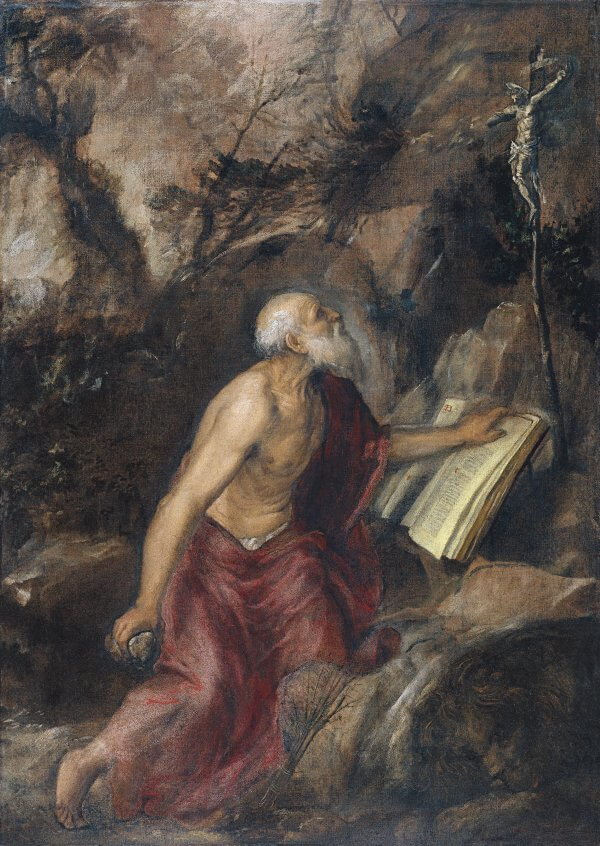
Titian is an outstanding representative of the Venetian school of art. He created The Penitent Saint Jerome a year before his death.
The life of Saint Jerome was depicted on the canvases of Renaissance artists more than once, and Titian portrayed Saint Jerome numerous times. You can find the earliest painting of Saint Jerome in the Louvre, Paris.
In the version represented in the Thyssen-Bornemisza Museum, he omitted many elements of his previous pictures and focused on the figure of Saint Jerome.
In this painting, Titian conveyed the idea of repentance with the hands and eyes of Saint Jerome.
Titian wrote his last painting, Lamentation of Christ, for his own tombstone. He died of the plague in Venice on August 27, 1576, having been infected by his son, whom he devotedly looked after.
7. The Annunciation, El Greco, 1576
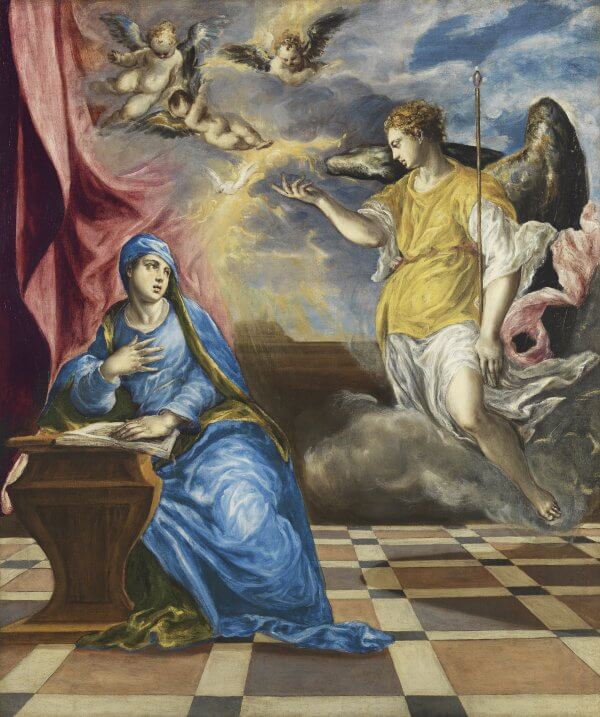
El Greco was a Spanish painter, sculptor, and architect of the Spanish Renaissance. The nickname El Greco reflects his Greek origin and Spanish citizenship. He usually signed his works with his full name in Greek letters, Δομήνικος Θεοτοκόπουλος, sometimes adding the word Κρής (“from Crete”).
During his creative life, the artist painted many versions of the Annunciation; these paintings show the transformation of his style. The Thyssen-Bornemisza Museum has one of the latest versions, painted in Italy.
8. Saint Catherine of Alexandria, Caravaggio, 1598-99
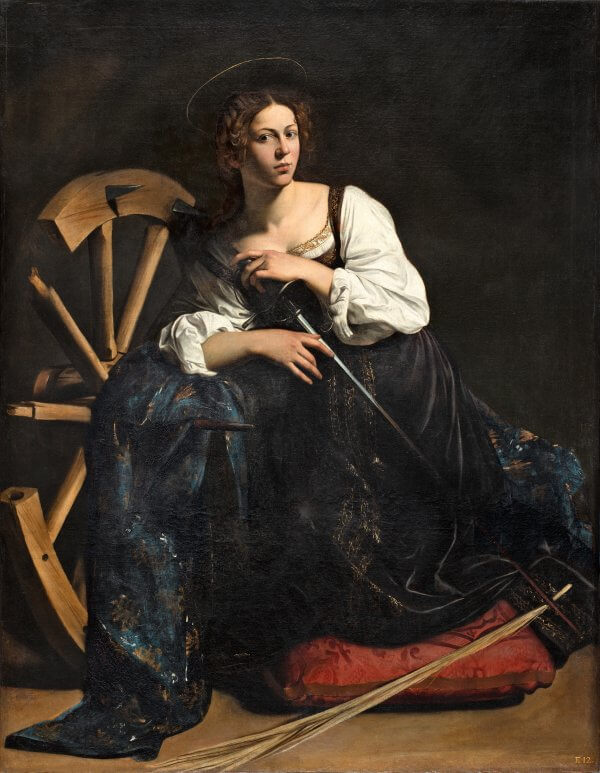
Michelangelo Merisi da Caravaggio was an Italian painter, one of the most prominent representatives of the Baroque style. The art of Caravaggio greatly influenced the works o many Western European masters of the 17th century.
The painting Saint Catherine of Alexandria was painted at the request of Cardinal Francesco del Monte when Caravaggio lived with him.
Saint Catherine of Alexandria was originally from Alexandria. Her martyrdom is attributed to 307 AD.
The young courtesan Fillide Melandroni, with whom the artist had a romantic relationship, posed for the picture. She also posed for other of his works.
9. Venus and Cupid, Peter Paul Rubens, 1606-1611
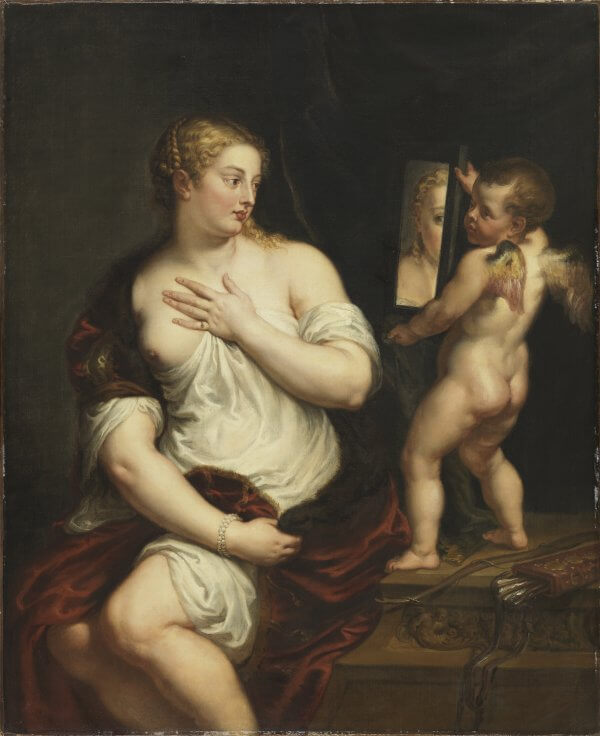
Peter Paul Rubens was a Dutch (Flemish) painter and one of the founders of Baroque art. The creative heritage of Rubens includes about 3,000 paintings, a significant part of which were made in collaboration with students and colleagues.
During his life, Rubens created over 30 paintings depicting Venus. This version, the Venus and Cupid, was painted based on the original painting by Titian.
10. The Death of Hyacinthus, Giambattista Tiepolo, 1752-1753
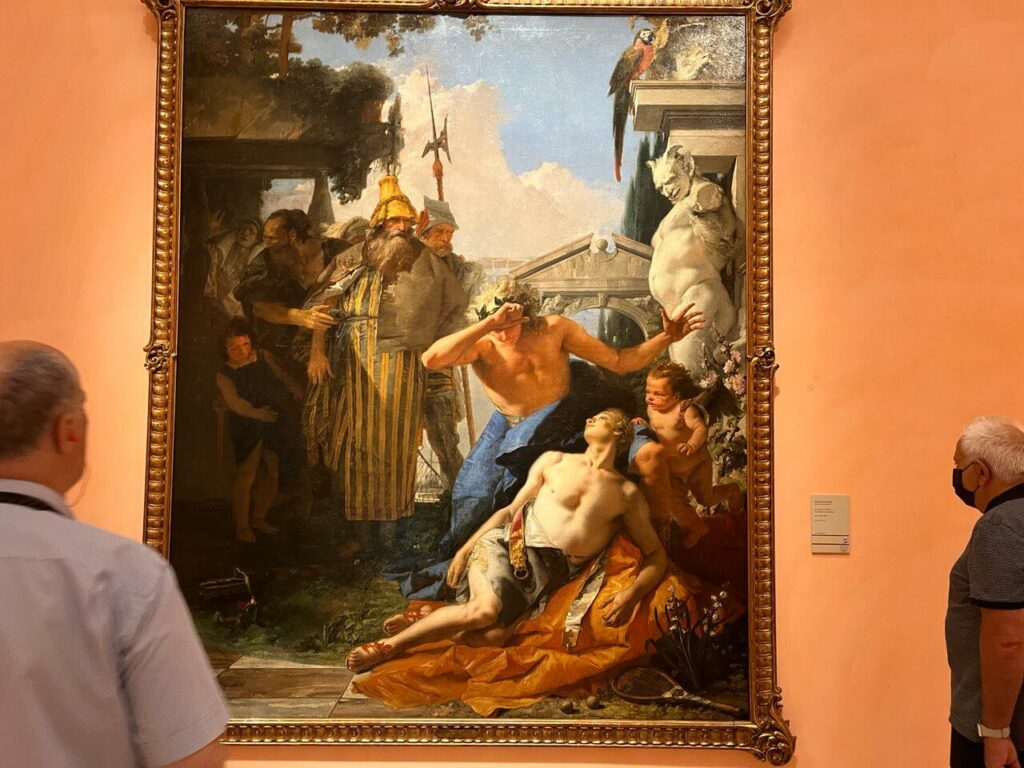
Giambattista Tiepolo was an Italian painter and engraver, decorator, frescoist, representative of the Venetian school.
The Death of Hyacinthus was commissioned by 28-year-old Count Wilhelm Friedrich Schaumburg-Lippe in memory of his lover, a young Spanish musician. The canvas depicts an episode from Ovid’s Metamorphoses. Tiepolo depicted the scene based on an Italian text translation in 1561.
The disc throwing from the original scene is replaced by tennis, which was popular among the aristocrats of the time. A racquet and some balls are visible in the foreground, while a tennis court net is in the background.
Hyacinthus dies in the eyes of a desperate Apollo, who feels responsible for the accident.
11. Les Vessenots in Auvers, Vincent van Gogh, 1890
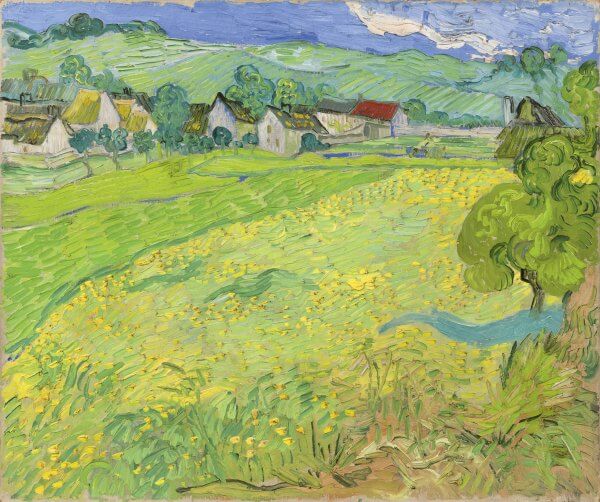
Vincent van Gogh is a Dutch Post-Impressionist painter whose work has had a timeless influence on 20th-century painting. During ten years, he created more than 2,100 works, including about 860 oil paintings.
The painting Les Vessenots in Auvers was painted a couple of months before his death in a small village 35 kilometers from Paris. He spent the last months of his life under the supervision of the physician Paul-Ferdinand Gachet.
Vincent van Gogh painted many rural landscapes during the last months of his life. At the time, he was in the grip of the most conflicting emotions: the feeling of freedom from the sights of vast fertile arable lands, mixed with deep longing and loneliness, which forced him to commit suicide.
12. Dream Caused by the Flight of a Bee around a Pomegranate a Second before Waking, Salvador Dalí, 1944
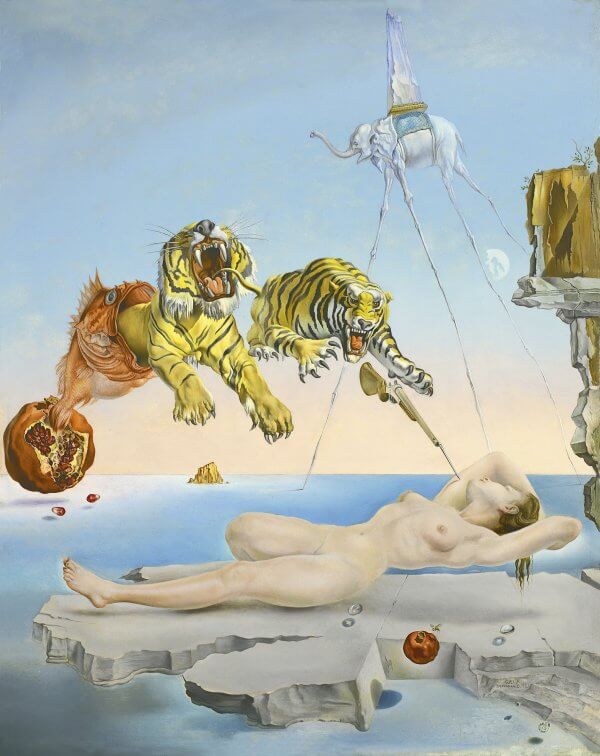
Salvador Dalí was a Spanish painter, graphic artist, sculptor, director, and writer, one of the most famous representatives of surrealism.
When painting the picture, the artist’s goal was to depict the type of long, meaningful dream discovered by Sigmund Freud, which is caused by an external stimulus, which simultaneously creates sleep and provokes awakening.
13. Hotel Room, Edward Hopper, 1931
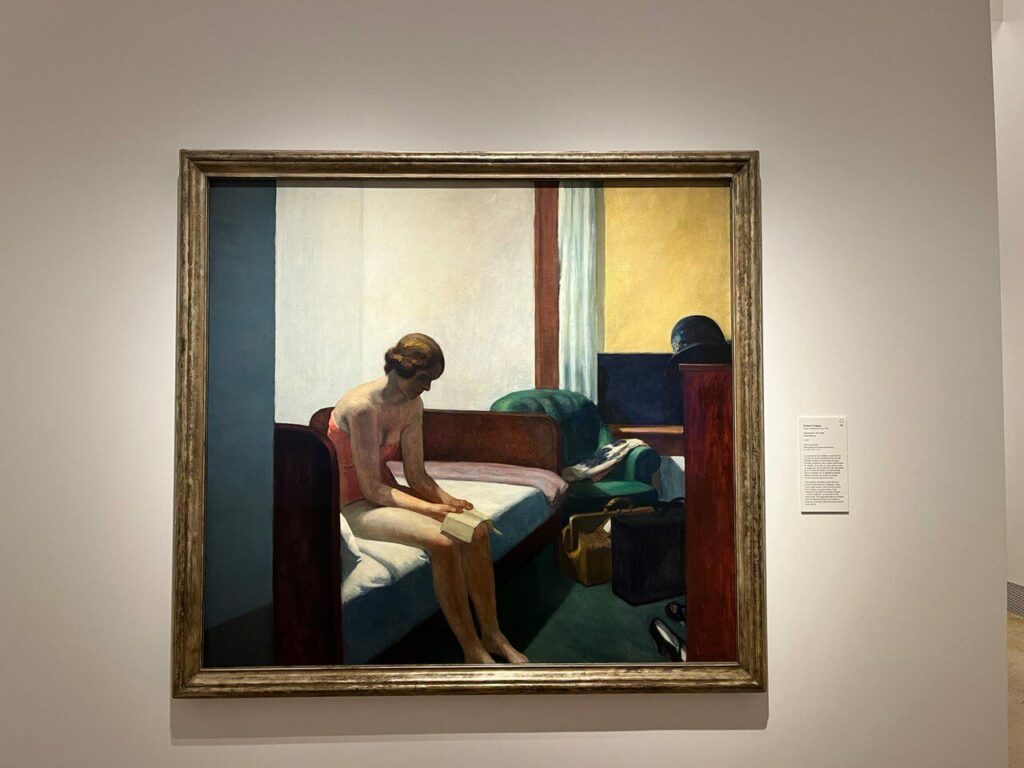
Edward Hopper was an American painter and engraver representing American genre painting.
Loneliness in big cities is the central theme of his work. This painting shows his wife, Josephine Verstille Nivison, who posed for this painting in a Washington Square studio.
What to see in Thyssen Bornemisza collection
- The Annunciation Dyptich, Jan van Eyck
- Portrait of Giovanna degli Albizzi Tornabuoni, Domenico Ghirlandaio
- Young Knight in a Landscape, Vittore Carpaccio
- Jesus Among the Doctors, Albrecht Dürer
- Landscape with the Rest on the Flight into Egypt, Joachim Patinir
- The Penitent Saint Jerome, Titian
- The Annunciation, El Greco
- Saint Catherine of Alexandria, Caravaggio
- Venus and Cupid, Peter Paul Rubens
- The Death of Hyacinthus, Giambattista Tiepolo
- Les Vessenots in Auvers, Vincent van Gogh
- Dream Caused by the Flight of a Bee around a Pomegranate a Second before Waking, Salvador Dalí
- Hotel Room, Edward Hopper
The history of the Museum
The history of the Thyssen collection begins with August Thyssen (1842-1926). At 29, he built a business empire in the iron and steel industry, which became very successful. Years later, he began to collect the first paintings, commissioning seven pieces of marble from the French sculptor Auguste Rodin. Four of these paintings are now part of the Carmen Thyssen-Bornemisza collection and are displayed in the museum’s lobby, welcoming visitors.
But the main collection that we can now see in the Museum was collected by his third son Heinrich Thyssen (1875-1947) and enlarged by his grandson Hans Heinrich (1921−2002). Heinrich Thyssen married the daughter of the Hungarian baron Gabor Bornemisza de Kazson, Margit. This marriage granted him a noble title and surname, adding Thyssen-Bornemisza to his own.
Beginning in 1920, Heinrich’s first major acquisitions began, his intention being to amass an extensive collection like a great museum.
What is Carmen Thyssen famous for?
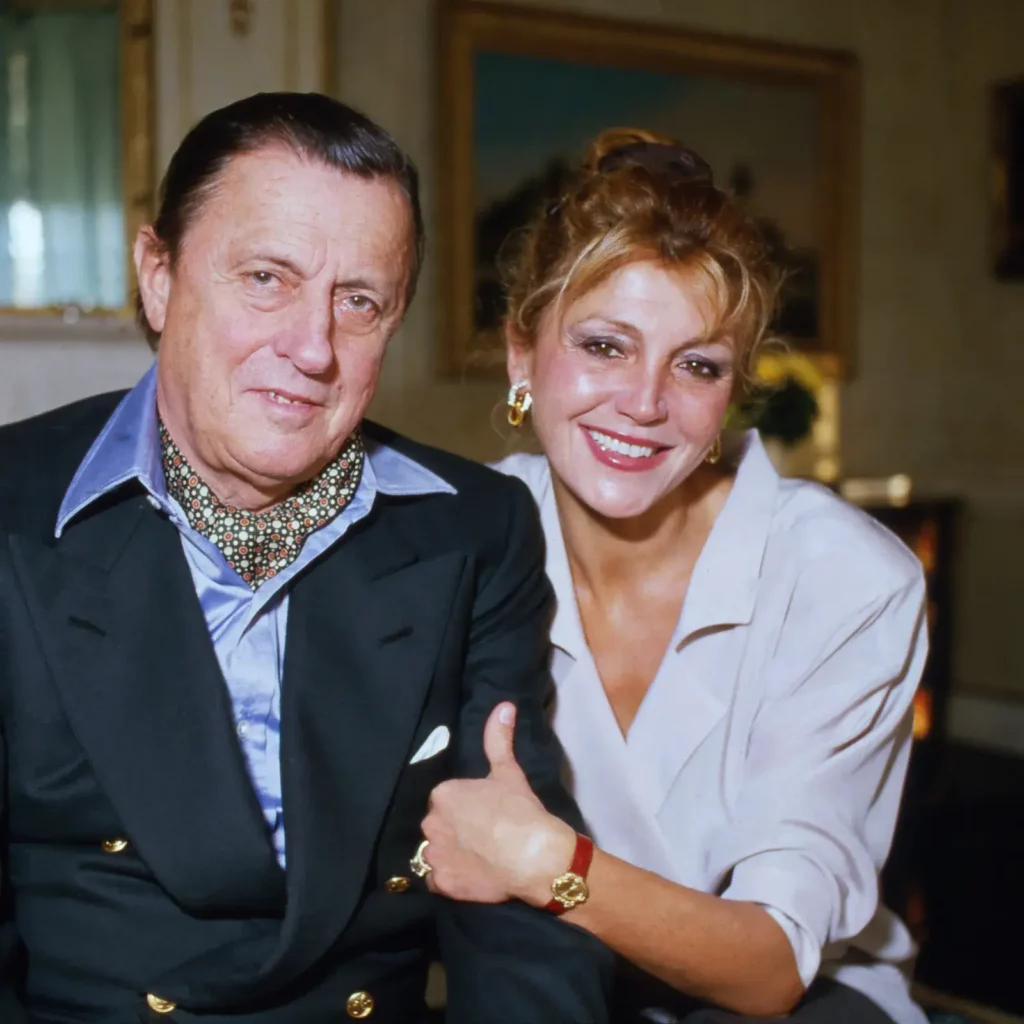
Carmen Cervera, also known as Tita Thyssen, is one of the most influential figures in Spanish cultural life. Born into a wealthy Catalan family, her father, an industrial engineer and businessman was fond of painting and collected paintings by Catalan artists.
As a child, she received an excellent education and studied English, French, Italian, and German. She later learned to play the piano, Decoration, and Drama.
In 1961 Carmen entered a beauty contest, escaping from the strict teaching given to her in her home. She became Miss Catalonia, and that same year, she contested and won the Miss Spain crown. Later, Carmen became Miss Europe and finished third in the Miss Universe pageant in Miami.
How to pronounce Thyssen Bornemisza
The Thyssen-Bornemisza pronounciation is [ˈtisem boɾneˈmisa].
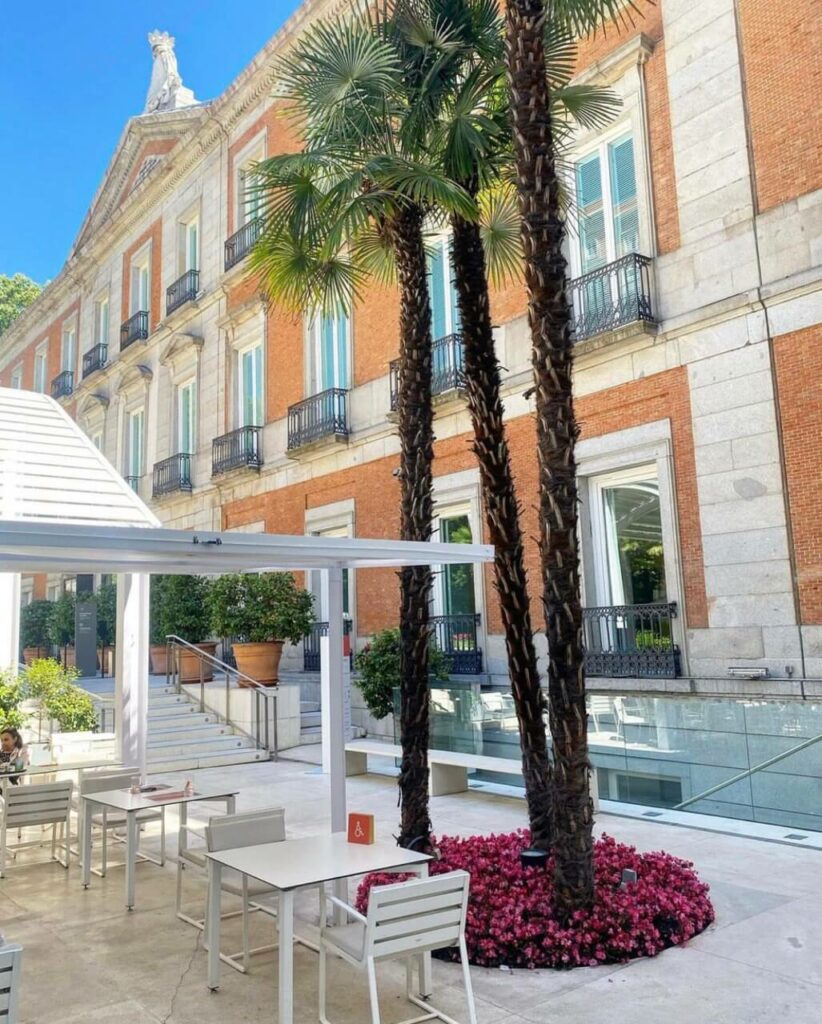
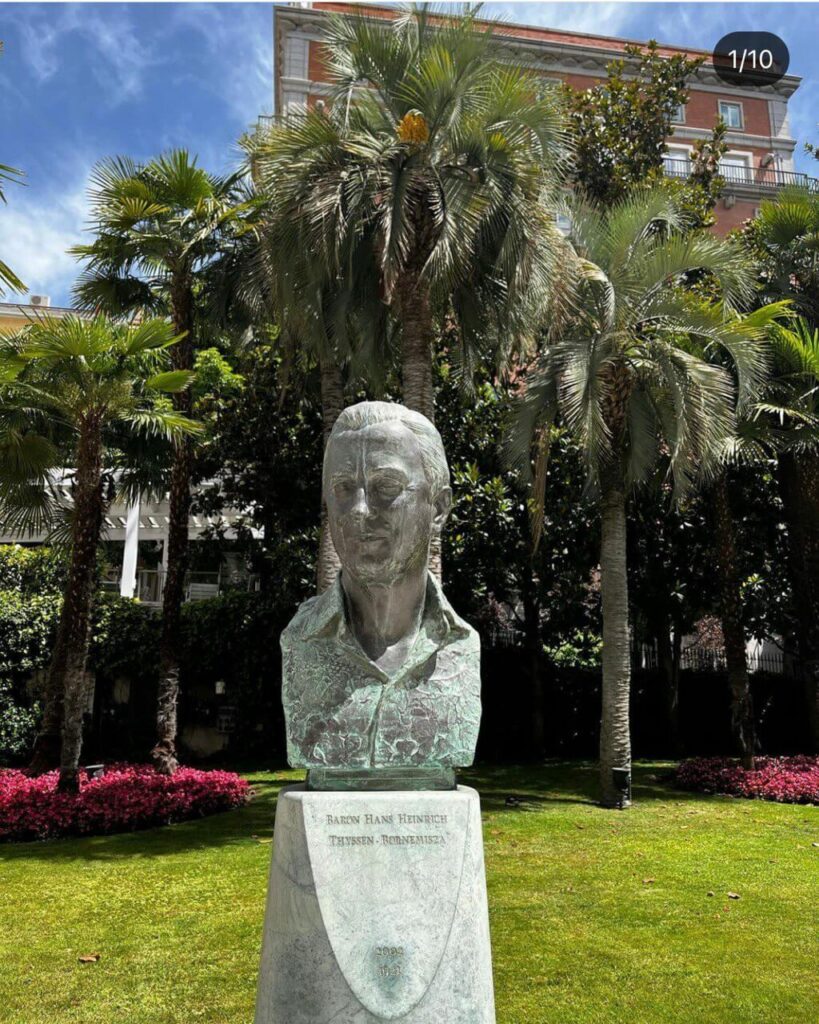
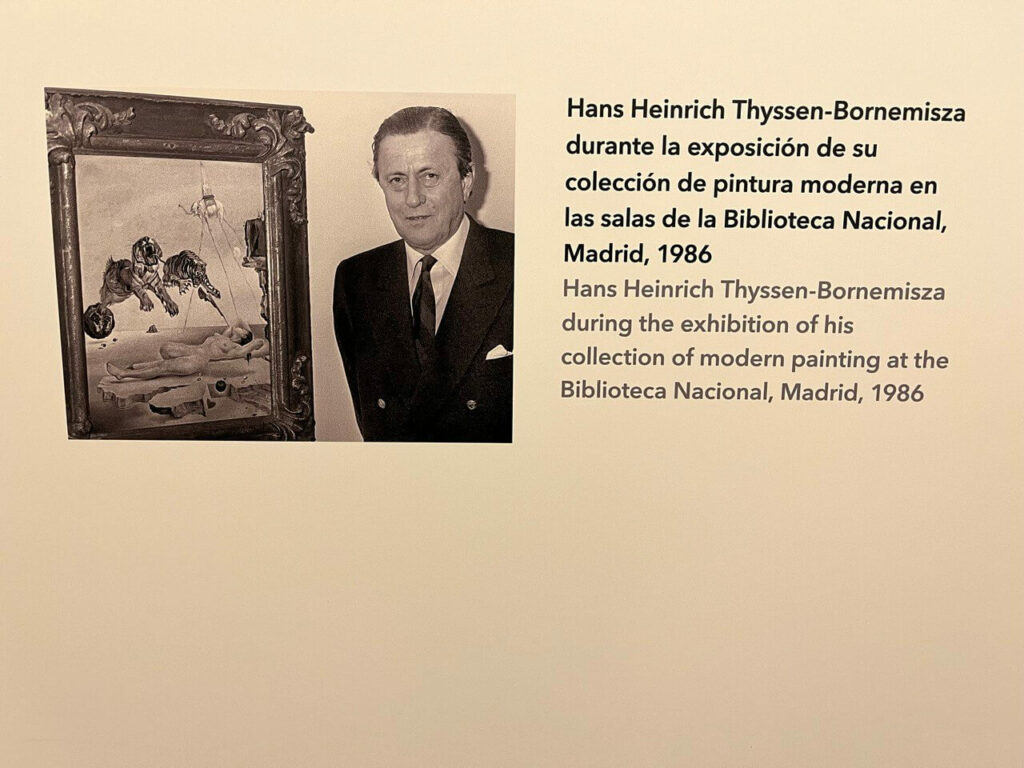
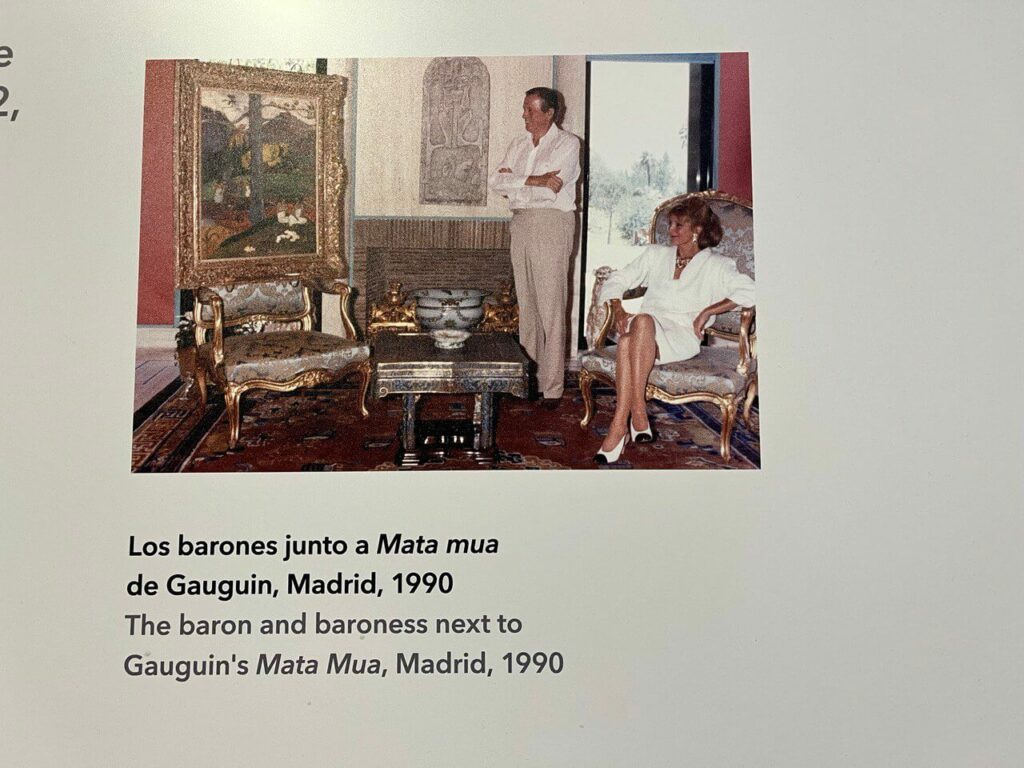
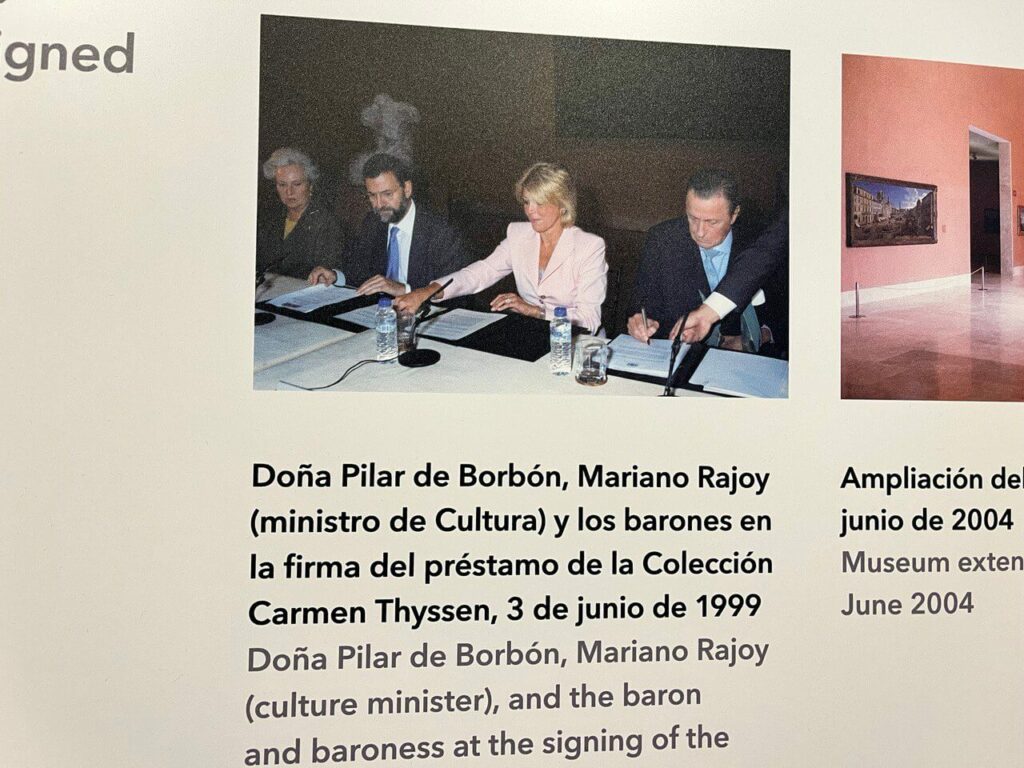
Schedule and free hours
The open hours are a bit different. You can follow this general schedule:
Free access Monday: 12.00-16.00
From Tuesday to Sunday: 10.00-19.00
You can find the detailed schedule at the official website.
Tickets
There are different types of tickets at Thyssen-Bornemisza museum:
- Full-Access ticket, starting from €9. Includes access to the permanent exhibition, Carmen Thyssen collection, and temporary exhibitions. Free tickets are available for teachers, persons with disability, youth card holders, etc.
- Full-Access ticket with the audioguide, starting from €5 (teachers, persons with disability, youth card holders, etc.) and from €14 to the general public.
- Ticket with the menu. Includes a meal at the museum’s café. The price ranges from €16.5 to €29.5.
You can also buy a €32 ticket to Madrid’s Golden Triangle: Prado Museum + Thyssen-Bornemisza + Reina Sofia.
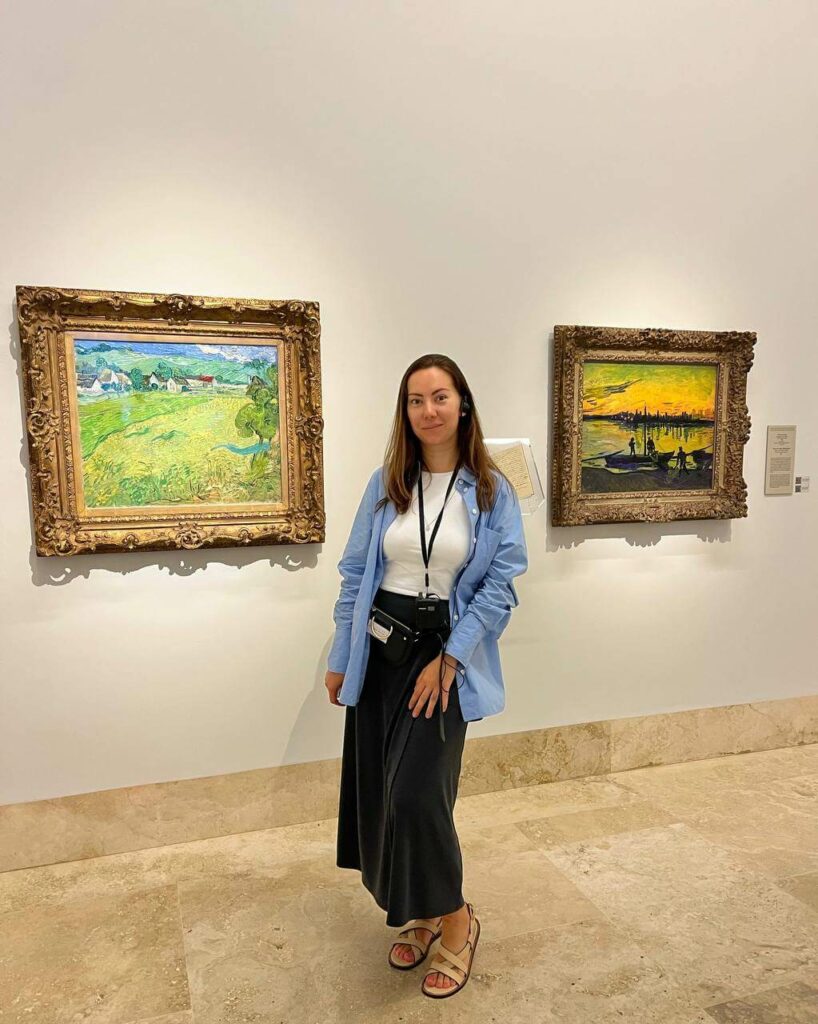
See also: Famous Paintings at Prado Museum

